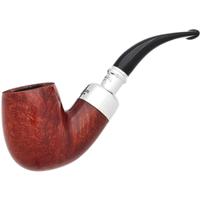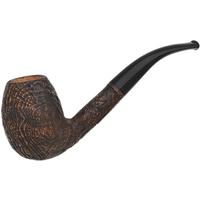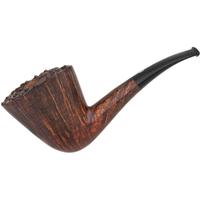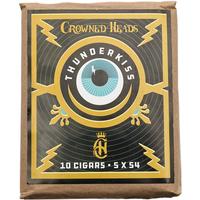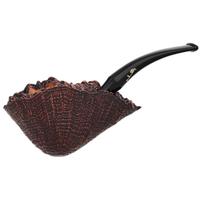WLT Dark Air Cured
- Thread starter makhorkasmoker
- Start date
You are using an out of date browser. It may not display this or other websites correctly.
You should upgrade or use an alternative browser.
You should upgrade or use an alternative browser.
Where did you get this information about One Sucker? I have been looking for a reliable and thorough guide to tobacco varieties, classes and their uses for some time now. Especially older heirloom varieties.It sounds to me like you are describing One Sucker, which is indeed a Burley, technically, though with different growth habit than more traditional types of Burley, such as TN 86.
As for the dark air cured I’ve reviewed here, it was sold, by Whole Leaf Tobacco, as “dark air cured.” Every source I have found assures me that dark air cured is a different class than burley. And it tastes nothing like any burley I have ever tried, including whole leaf burleys.
Where did you get this information about One Sucker? I have been looking for a reliable and thorough guide to tobacco varieties, classes and their uses for some time now. Especially older heirloom varieties.
As for the dark air cured I’ve reviewed here, it was sold, by Whole Leaf Tobacco, as “dark air cured.” Every source I have found assures me that dark air cured is a different class than burley. And it tastes nothing like any burley I have ever tried, including whole leaf burleys.
I live in Tennessee and work in agriculture. Some of my favorite days are spent in the north central part of the state - Smith, Stewart, Macon, and Robertson Counties primarily - and there is some tobacco still being grown there (though not like it was even 10 years ago, let alone 75 years ago). Much of it is One Sucker (a madole type of Burley). While some of that *may* be dark fire cured, most of it is air cured hung on sticks in tall barns before being sold to the dip and chew people. There is also a fair bit of traditional Burleys (with the wide leaves) being grown similar to what you find in middle Kentucky - it is often dark fired and sold for Italian cigars, pipe tobacco, and perhaps other manufacturers I'm not aware of. The farmers are all fairly tight-lipped about their varietals, processing methods, and client lists. I know some of the stuff ends up in cigarettes somewhere, but we cannot figure out where - if you've ever smoked One Sucker by itself, you may begin to understand.
Almost all smoking tobacco (excepting N. rustica) is N. tabacum. Differences in leaf (Burley vs. Virginia vs. Oriental) is due to specific genotypes and phenotypes expressed in different "strains." When you grow out a Lemon Virginia seed, for example, you are going to get certain characteristics: higher sugar content, more acidity, the ability for it hold a beautiful yellowish color before it is fully cured. Whether tobacco is air cured, fire cured, or flue cured is another matter. You can use either method for any of them, although virginias are usually flue cured to reduce acidity while Burleys are usually air cured to preserve the sugar content. Dark-firing begins to caramelize the sugars somewhat while imparting a smoky taste that varies based on which woods are used. Tobacco can be sold be which varietal it is, or which method was used to process and cure it.
The reason I said it sounded like you were talking about One Sucker was because it was air cured, it's dark, and has been used as a Perique substitute. I would have to check, but I believe the "Perique" strain is actually a fork from One Sucker genetics that's been continuously grown in Louisiana for some time now. I can't remember where I read that unfortunately.
If you are looking for info about certain tobacco varietals, your best bets are companies that sell the seed to consumers (I purchase from Victory Seeds for my home tobacco garden), or various publications from University Ag Departments and governmental offices that serve the Ag community. Most of that is all online. Due to people keeping proprietary info secret - from farmers to processors to distributors to manufacturers of the final product - you may also check out the Fair Trade tobacco grower's forum Fair Trade Tobacco | How to Grow, Cure and Process Tobacco. - https://fairtradetobacco.com/
There's rabbit holes galore in the manufacturing side of the tobacco world and there are some very experienced, very helpful, and very talented people who post there regularly. I suspect some of them to be commercial tobacco producers, due to their knowledge.
If you're looking for a reliable and thorough guide, I'd say the market has a need for one. Perhaps some ambitious author can compile one and make their million?
Thank you for the information!I live in Tennessee and work in agriculture. Some of my favorite days are spent in the north central part of the state - Smith, Stewart, Macon, and Robertson Counties primarily - and there is some tobacco still being grown there (though not like it was even 10 years ago, let alone 75 years ago). Much of it is One Sucker (a madole type of Burley). While some of that *may* be dark fire cured, most of it is air cured hung on sticks in tall barns before being sold to the dip and chew people. There is also a fair bit of traditional Burleys (with the wide leaves) being grown similar to what you find in middle Kentucky - it is often dark fired and sold for Italian cigars, pipe tobacco, and perhaps other manufacturers I'm not aware of. The farmers are all fairly tight-lipped about their varietals, processing methods, and client lists. I know some of the stuff ends up in cigarettes somewhere, but we cannot figure out where - if you've ever smoked One Sucker by itself, you may begin to understand.
Almost all smoking tobacco (excepting N. rustica) is N. tabacum. Differences in leaf (Burley vs. Virginia vs. Oriental) is due to specific genotypes and phenotypes expressed in different "strains." When you grow out a Lemon Virginia seed, for example, you are going to get certain characteristics: higher sugar content, more acidity, the ability for it hold a beautiful yellowish color before it is fully cured. Whether tobacco is air cured, fire cured, or flue cured is another matter. You can use either method for any of them, although virginias are usually flue cured to reduce acidity while Burleys are usually air cured to preserve the sugar content. Dark-firing begins to caramelize the sugars somewhat while imparting a smoky taste that varies based on which woods are used. Tobacco can be sold be which varietal it is, or which method was used to process and cure it.
The reason I said it sounded like you were talking about One Sucker was because it was air cured, it's dark, and has been used as a Perique substitute. I would have to check, but I believe the "Perique" strain is actually a fork from One Sucker genetics that's been continuously grown in Louisiana for some time now. I can't remember where I read that unfortunately.
If you are looking for info about certain tobacco varietals, your best bets are companies that sell the seed to consumers (I purchase from Victory Seeds for my home tobacco garden), or various publications from University Ag Departments and governmental offices that serve the Ag community. Most of that is all online. Due to people keeping proprietary info secret - from farmers to processors to distributors to manufacturers of the final product - you may also check out the Fair Trade tobacco grower's forum Fair Trade Tobacco | How to Grow, Cure and Process Tobacco. - https://fairtradetobacco.com/
There's rabbit holes galore in the manufacturing side of the tobacco world and there are some very experienced, very helpful, and very talented people who post there regularly. I suspect some of them to be commercial tobacco producers, due to their knowledge.
If you're looking for a reliable and thorough guide, I'd say the market has a need for one. Perhaps some ambitious author can compile one and make their million?
Yes, I spend a lot of time over on the fair trade tobacco forums, and reading about seed varieties too.
To be clear, when I said that about dark air cured being used like perique, I was referring to posts of home growers over on the Fair trade forums, other forums, and I believe here, many of which say it can be used that way, and I get the feeling they say this at least in part because dark air cured is so different and so little known nowadays in the pipe world that they are straining a bit to find comparisons that the average pipe smoker will understand.
The point I was trying to make in my review is that the dark air cured I’m smoking is quite UNLIKE perique. It does not have the “stewed fruit” flavors that perique has when blended (and I now know it tastes nothing like straight perique either).
I do hope to grow some tabacum varieties in the future and one sucker will be on my list. So far I have grown only varieties of rustica .
Thank you for the information!
Yes, I spend a lot of time over on the fair trade tobacco forums, and reading about seed varieties too.
To be clear, when I said that about dark air cured being used like perique, I was referring to posts of home growers over on the Fair trade forums, other forums, and I believe here, many of which say it can be used that way, and I get the feeling they say this at least in part because dark air cured is so different and so little known nowadays in the pipe world that they are straining a bit to find comparisons that the average pipe smoker will understand.
The point I was trying to make in my review is that the dark air cured I’m smoking is quite UNLIKE perique. It does not have the “stewed fruit” flavors that perique has when blended (and I now know it tastes nothing like straight perique either).
I do hope to grow some tabacum varieties in the future and one sucker will be on my list. So far I have grown only varieties of rustica .
I wonder what that dark air cured would be like rehydrated and pressed into barrels under pressure? The fermentation process has so much to do with the final product. I have absolutely no knowledge of what happens between field and barrel for the Perique.
I will say if you got absolutely no fruity flavors, it may not be One Sucker after all. One Sucker in a pipe is damned strong, but has a nice vein of fruity flavors to me.
As a plant nerd and gardener, I often wish pipe and cigar manufacturers were more forthcoming about what they were selling, but I completely understand why they are not.
I love growing Rustica. I have a batch I need to process into some snuff. It'll be a first for me, and I almost hope I don't like it too much because I have a few jars of the leaf that's going on 4 years old. Time to experiment!
So f
Good luck with the rustica experiments! I cured mine in the Native American/makhorka style—intentionally keeping it green
So far I’m getting zero fruit flavor with it. It’s all bitter chocolate/ coffee type flavors, with some spice.I wonder what that dark air cured would be like rehydrated and pressed into barrels under pressure? The fermentation process has so much to do with the final product. I have absolutely no knowledge of what happens between field and barrel for the Perique.
I will say if you got absolutely no fruity flavors, it may not be One Sucker after all. One Sucker in a pipe is damned strong, but has a nice vein of fruity flavors to me.
As a plant nerd and gardener, I often wish pipe and cigar manufacturers were more forthcoming about what they were selling, but I completely understand why they are not.
I love growing Rustica. I have a batch I need to process into some snuff. It'll be a first for me, and I almost hope I don't like it too much because I have a few jars of the leaf that's going on 4 years old. Time to experiment!
Good luck with the rustica experiments! I cured mine in the Native American/makhorka style—intentionally keeping it green
Thank you for the information!
Yes, I spend a lot of time over on the fair trade tobacco forums, and reading about seed varieties too.
To be clear, when I said that about dark air cured being used like perique, I was referring to posts of home growers over on the Fair trade forums, other forums, and I believe here, many of which say it can be used that way, and I get the feeling they say this at least in part because dark air cured is so different and so little known nowadays in the pipe world that they are straining a bit to find comparisons that the average pipe smoker will understand.
The point I was trying to make in my review is that the dark air cured I’m smoking is quite UNLIKE perique. It does not have the “stewed fruit” flavors that perique has when blended (and I now know it tastes nothing like straight perique either).
I do hope to grow some tabacum varieties in the future and one sucker will be on my list. So far I have grown only varieties of rustica .
I wonder what that dark air cured would be like rehydrated and pressed into barrels under pressure? The fermentation process has so much to do with the final product. I have absolutely no knowledge of what happens between
I will say if you got absolutely no fruity flavors, it may not be One Sucker after all. One Sucker in a pipe is damned strong, but has a nice vein of fruity flavors to me.
As a plant nerd and gardener, I often wish pipe and cigar manufacturers were more forthcoming about what they were selling, but I completely understand why they are not.
So f
So far I’m getting zero fruit flavor with it. It’s all bitter chocolate/ coffee type flavors, with some spice.
Good luck with the rustica experiments! I cured mine in the Native American/makhorka style—intentionally keeping it green
I ended up with some now dark green Rustica - a followed a German and Polish snuff-making technique of letting the leaves freeze in the plant before harvest. Green snuffs are some of the strongest you can find.
I agree. Never had perique of any type that tasted or smelled like fruit.Very cool.
For the record, perique doesn't taste like dried fruit. It taste very astringent... like acidy. However, it does change the flavors of the tobaccos it is blended with, and some gold to red Virginias can take on a stewed fruit aroma when blended with perique.
This is the ingredient I need to make something similar to Picayune, at least I think. Nothing comes close so far. Mark Ryan did tell me at the Richmond show that the dark air cured is what makes Picayune unique. I’m still learning about it. Thanks!Dark Air Cured is, as the name implies, an air cured tobacco that is dark, both in color and in tones of flavor. The one I tried, from Whole Leaf Tobacco, has a deep, bold, spicy flavor reminiscent of unsweetened espresso or only barely sweetened strong dark chocolate. It also has a very strong nicotine hit--stronger than 5 Brothers or Dark Bird's Eye or any of the C&D power burleys I have tried.
To be clear, dark air cured is not burley, nor is it "dark burley." It's air cured like a burley, but it comes from a different type of tobacco plant.
If you read up on Dark Air Cured on-line, you'll find it often described--or dismissed--as chew tobacco, and this is, nowadays, somewhat true. . I for one cannot find a commercial pipe blend for sale here in the U.S. that includes dark air cured. But you can buy it whole leaf from various places.
View attachment 333080
You will also read about it as a sort of perique substitute. Some smokers claim it has dried fruit flavors in the way perique sometimes does. This was not my experience. It might help deliver a perique-like nic hit, maybe a hint of pepper, but there the similarities end. I'm not saying these perique comparisons are untrue. There are many different varieties of dark air cured and I would suspect each of them has different qualities. the flavors of the one I tried are definitely savory.
My understanding is that dark air cured is one of the tobaccos used in old school continental blends--the stuff of Gauloise and Ducados cigarettes I used to smoke a long time ago, and also pipe blends like Scaferlati Caporal. In other words, this is the stuff that helped Maigret solve so many murders and Jean Paul Sartre to popularize existentialism.
It is also a form of the tobaccos smoked by country folk in areas of Latin America. If you read Born To Run--the account of how Tarahumara Indian runners kicked ass at the Leadville 100--you'll find them puffing dark air cured rollies before running a hundred miles of rough terrain at high elevations.
Some things to note: the leaves are thick, and this is not the easiest tobacco in the world to keep lit. On the bright side, because whole leaf products have no PG, it will dry out really fast, and you can rehydrate it equally fast to your liking. You can also adjust the cut to improve the burn.
some people to a lot of trouble making plugs and flakes. Maybe one day I will too.
Basically I removed the central rib
View attachment 333121
rolled it up fairly tight
View attachment 333122
, and sliced it into coins.
View attachment 333124
Then I cut the coins across a few times.
View attachment 333126
I describe the process because I was a bit intimidated by the prospect of dealing with whole leaves. Turned out to be pretty easy--with a sharp knife.
I'm enjoying dark air cured straight (in small bowls) and also in various blends. Well worth a try if you enjoy bold, strong tobacco.
If what Brooklynpiper suggests above is true, it may be a secret ingredient, or least one that is often not listed, in picayune and who knows how many other blends. If so I wonder why it is so rarely mentioned in ingredients when other components—Virginia, burley, dark fired—are.This is the ingredient I need to make something similar to Picayune, at least I think. Nothing comes close so far. Mark Ryan did tell me at the Richmond show that the dark air cured is what makes Picayune unique. I’m still learning about it. Thanks!
I would give it a shot. It certainly can add a bit of kick, and maybe get you closer flavor-wise. I’ve never tried picayune so I don’t know
Picayune is the one blend I hear mentioned that I really wish I had the opportunity to try. I've only been smoking a pipe for two years and it seems Picayune was long gone by then. If you ever get a home blend that's similar and are willing to share, I'd love to get the "recipe".This is the ingredient I need to make something similar to Picayune, at least I think. Nothing comes close so far. Mark Ryan did tell me at the Richmond show that the dark air cured is what makes Picayune unique. I’m still learning about it. Thanks!
So what Varietal is Dark Air Cured? Burley, Virginia, something else? Im pretty sure DAC just describes the process in which its cured?
The USDA puts it in a class of its own, separate from cigar types, burleys, etc
The two dark air cured varieties I am most familiar with are Goose Creek Red and Staghorn. I love them both and they are quite different from each other. The former is more like the brown twists Gawith makes, the later certainly has a dark stewed fruit vibe
I wonder what is the type of dark burley they cultivate in Italy and France?



